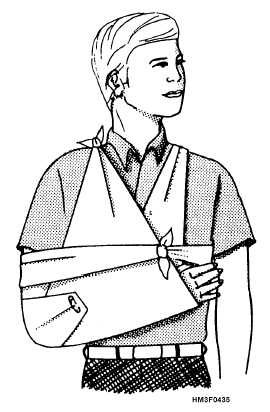Treat for shock.
Do not attempt to locate a fracture by grating the
ends of the bone together.
Do not attempt to set a broken bone unless a
medical officer will not be available for many
days.
When a long bone in the arm or leg is fractured,
the limb should be carefully straightened so that
splints can be applied, unless it appears that
further damage will be caused by such a
maneuver. Never attempt to straighten the limb
by applying force or traction with any
improvised device. Pulling gently with your
hands along the long axis of the limb is
permissible and may be all that is necessary to
get the limb back into position.
Apply splints. If the victim is to be transported
only a short distance, or if treatment by a medical
officer will not be delayed, it is probably best to
leave the clothing on and place emergency
splinting over it. However, if the victim must be
transported for some distance, or if a
considerable period of time will elapse before
treatment by a medical officer, it may be better to
remove enough clothing so that you can apply
well padded splints directly to the injured part. If
you decide to remove clothing over the injured
part, cut the clothing or rip it along the seams. In
any case, be careful! Rough handling of the
victim may convert a closed fracture into an
open fracture, increase the severity of shock, or
cause extensive damage to the blood vessels,
nerves, muscles, and other tissues around the
broken bone.
If the fracture is open, you must take care of the
wound before you can deal with the fracture.
Bleeding from the wound may be profuse, but
most bleeding can be stopped by direct pressure
on the wound. Other supplemental methods of
hemorrhage control are discussed in the section
on wounds of this chapter. Use a tourniquet as a
last resort. After you have stopped the bleeding,
treat the fracture.
Now that we have seen the general rules for
treating fractures, we turn to the symptoms and
emergency treatment of specific fracture sites.
Forearm Fracture
There are two long bones in the forearm, the radius
and the ulna. When both are broken, the arm usually
appears to be deformed. When only one is broken, the
other acts as a splint and the arm retains a more or less
natural appearance. Any fracture of the forearm is
likely to result in pain, tenderness, inability to use the
forearm, and a kind of wobbly motion at the point of
injury.
If the fracture is open, a bone will show
through.
If the fracture is open, stop the bleeding and treat
the wound. Apply a sterile dressing over the wound.
Carefully straighten the forearm.
(Remember that
rough handling of a closed fracture may turn it into an
open fracture.) Apply a pneumatic splint if available;
if not, apply two well-padded splints to the forearm,
one on the top and one on the bottom. Be sure that the
splints are long enough to extend from the elbow to the
wrist. Use bandages to hold the splints in place. Put
the forearm across the chest. The palm of the hand
should be turned in, with the thumb pointing upward.
Support the forearm in this position by means of a wide
sling and a cravat bandage, as shown in figure 4-35.
The hand should be raised about 4 inches above the
level of the elbow. Treat the victim for shock and
evacuate as soon as possible.
Upper Arm Fracture
The signs of fracture of the upper arm include pain,
tenderness, swelling, and a wobbly motion at the point
4-47
Figure 4-35.—First aid for a fractured forearm.

